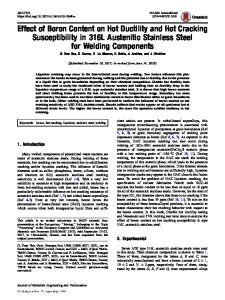Effect of hot working on structure and strength of type 304L austenitic stainless steel
- PDF / 5,162,638 Bytes
- 19 Pages / 594 x 774 pts Page_size
- 25 Downloads / 297 Views
I.
INTRODUCTION
FORGING is a useful technique to produce complex nearnet shape components for aerospace applications that require high strength-to-weight ratios. Typically, the strength levels of 300-series austenitic stainless steels in the annealed state, as well as those of precipitation-strengthened alloys such as JBK-75 (a modified A-286), are insufficient for their respective applications. Required strength levels can be provided via controlled evolution of microstructure and substructure during thermomechanical treatment (TMT). Strengthening of 304L has recently been critically reviewed in the context of a new requirement, minimum toughness. As a result, a strength window requirement has been imposed on the forging processor: a minimum strength level (a standard requirement) for enhanced strength-to-weight ratio and a maximum strength level (an added requirement) to guarantee a minimum level of toughness. In order to develop a rational approach to the specification of TMT schedules for optimal strength and toughness, processing history must be interrelated with as-forged structure and properties. Specifically, the evolution of microstructure and substructure depends on the relative proportions of dynamic and static recovery and recrystallization during TMT and, thus, on the applied temperature (T), strain (e), and strain rate (~) during deformation and cooling rate after deformation.
M.C. MATAYA, Associate Scientist, and M.P. RIENDEAU, Senior Development Engineer, are with EG&G Rocky Flats, Inc., Golden, CO 80402-0464. E.L. BROWN is a Metallurgical and Materials Consultant, Golden, CO. Manuscript submitted January 3, 1990. METALLURGICAL TRANSACTIONS A
The evolution of dynamically recovered and recrystallized microstructures as a function of deformation parameters and material parameters, such as stacking fault energy (SFE), has been studied and reviewed, tH~ Correlations exist among T, e, and ~ and dynamically formed subgrain size, critical strain for dynamic recrystallization, high-temperature flow stress, and recrystallized grain size. In general, metals and alloys with high SFE, in which dislocation mobility is high, dynamically recover, while metals with relatively low SFE tend to dynamically recrystallize during deformation. Austenitic stainless steels dynamically recover but possess sufficiently low SFE to dynamically recrystallize when the critical strain for recrystallization for a given set of T and ~ is exceeded. In addition to the dynamic processes, static recovery and recrystallization are also important restoration processes at elevated temperatures t1~ and are driven by residual stored energy of deformation produced dynamically during TMT. Static recrystallization has been identified as the controlling mechanism with regard to development of properties and structure during highenergy-rate forging (HERF) of a precipitation-strengthened austenitic alloy JBK-75 t17] and during multiple-step compression of alloy 718. us']9] A number of empirical models employing physically meaningful material a
Data Loading...











